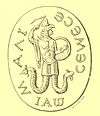Thought of Norea
| Part of a series on | |||
| Gnosticism | |||
|---|---|---|---|
 | |||
| History | |||
| Proto-Gnostics | |||
| Scriptures | |||
|
|||
| Lists | |||
| Related articles | |||
The Thought of Norea is a brief Sethian Gnostic text. The main surviving copies come from the Nag Hammadi library. The Thought of Norea is sometimes considered to belong to the New Testament apocrypha. It is one of the shorter texts of the Nag Hammadi collection and is estimated to have been written In the second century C.E.[1]
Norea
The text, consisting of four paragraphs, is an ode to Norea, one of the emanations in Gnostic cosmology, the syzygy of Adam, and Sophia after her fall from grace. Norea has several identities within Gnosticism: she can be Eve’s daughter and Seth’s wife and sister, or she can be Noah or Shem’s wife. In the Thought of Norea, she is connected to Sophia. She furthermore exemplifies the journey of the soul to acquire the divine knowledge necessary for salvation[1]
Sethian Gnosticism
The text is thought to be from the Sethian sect of Gnostics, the sect who view biblical Seth as their hero, who was reincarnated as Jesus. Their other texts include the Apocalypse of Adam, Apocryphon of John, the Three Steles of Seth, the Trimorphic Protennoia, and the Coptic Gospel of the Egyptians.
Text
"Father of All, Ennoia of the Light, dwelling in the heights above the (regions) below, Light dwelling in the heights, Voice of Truth, upright Nous, untouchable Logos, and ineffable Voice, incomprehensible Father!
It is Norea who cries out to them. They heard, [and] they received her into her place forever. They gave it to her in the Father of Nous, Adamas, as well as the voice of the Holy Ones, in order that she might rest in the ineffable Epinoia, in order that [she] might inherit the first mind which [she] had received, and that [she] might rest in the divine Autogenes, and that she (too) might generate herself, just as she also has inherited the living Logos, and that she might be joined to all of the Imperishable Ones, and speak with the mind of the Father.
And she began to speak with the words of Life, and [she] remained in the presence of the Exalted One, possessing that which she had received before the world came into being. She has the great mind of the Invisible One, and she gives glory to [her] Father, and she dwells within those who [are actively awake] within the Pleroma, and she beholds the Pleroma.
There will be days when she will behold the Pleroma, and she will not be in deficiency, for she has the four holy helpers who intercede on her behalf with the Father of the All, Adamas. He it is who is within all of the Adams, possessing the thought of Norea, who speaks concerning the two names which create a single name."[2]
References
- 1 2 director, James M. Robinson, (1977). The Nag Hammadi Library : Chenoposkion Manuscripts English (1st U.S. ed.). New York: Harper & Row. pp. 404–405. ISBN 0-06-066929-2.
- ↑ Giversen, Søren; Pearson, Birger A. "The Thought of Norea - The Nag Hammadi Library". The Gnostic Society Library. Retrieved November 2012. Check date values in:
|access-date=(help)